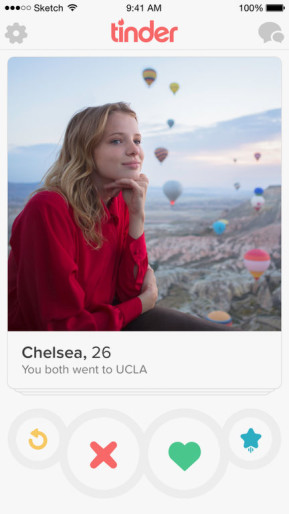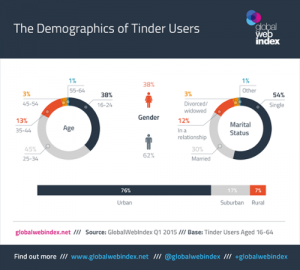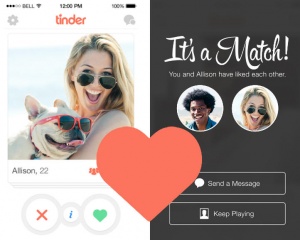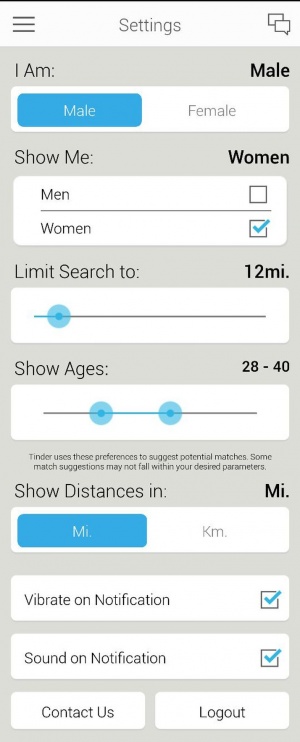Difference between revisions of "Tinder"
(re-arranging of ethical implications - s.d.) |
|||
| Line 17: | Line 17: | ||
}} | }} | ||
| − | + | ||
==History== | ==History== | ||
Revision as of 20:14, 23 April 2017
|
Contents
History
Sean Rad, Justin Mateen, and Jonathan Badeen are the founders of Tinder. Sean and Justin both grew up in Los Angeles and knew of each other since they both went to private high school together. However, they did not become close until their freshman year of college in a math class at USC in Fall 2004.[1]
In 2009, Sean launched Adly, a celebrity social advertising platform where users create campaigns.[2] He shortly sold the company in Fall 2011 due to a decrease of interest in dealing with celebrities and advertisers. Sean then joined an incubator called Hatch Labs, funded by IAC and Xtreme Labs (Hatch Labs was later shut down in 2013).[3] There Sean met Jonathan Badeen, and the three of them came up with the idea of Tinder. This dating application mimics another application called Hot or Not, a rating site where users rate the attractiveness of the person in the photograph on a scale of 1-10.[4] However, now Hot or Not has a very similar system to Tinder now, instead of swiping left or right to match with someone Hot or Not has an button with a heart on it to match with someone and a button with an "X" on it to deny someone.
Tinder was seeded on a few college campuses and later spread to more campuses due to the increasing attention it received among college students. The dating application started off with a user base primarily made up of 18-24 years old and has now expanded widely to other age groups, where 45% of users are between 25 – 34 years old.[5]
Tinder was released on September 12, 2012. As of March 2015, there are 196 countries who use Tinder, roughly 50 million users, and 26 million matches made daily.[6]
How Tinder Works
Tinder is a free dating service application available for download on Android and iOS. When Tinder was launched, it was especially popular on college campuses, where students use the dating service for many possible reasons: meeting new friends, hooking-up, and finding significant others. Tinder has since become popular in markets beyond college students and has inspired a host of other Tinder-like apps.
In order to use Tinder, the application first asks for the user’s permission to access the user's Facebook profile to retrieve simple information such as the user’s name, age, photos, and interests. The application also uses Facebook to access the user’s mutual friends, likes and interests and matches the user with friends of mutual friends. This information is then used to create the user’s Tinder profile.
The user can then adjust the settings for their preference of gender, the user's age group, and how far the user is willing to travel to meet other Tinder users.
During the main phase of the app, the user browses through pictures of people who have a short biography tagged with them. If the user likes the person that they see on the screen, they can swipe right or tap the green heart icon. In the fall of 2015, Tinder added the ability to 'Super Like'. When used, recipients of the Super Like can see that their profile was more desirable to a certain user than any other profile out there. [7] If not, they can swipe left or tap the red cross icon. If both users swipe right on each others' profiles, the two users are notified that a match has been made and they can begin messaging each other.[8]
Controversies
Due to the widespread usage of Tinder, the dating service application has received mixed reviews.
On August 2015, Vanity Fair released an article titled "Tinder and the Dawn of the 'Dating Apocalypse,'" which blames Tinder and other dating applications for perpetuating hook-up culture. The article argues that due to the large selection of men and women on the site, people are forgetting the meaning of real relationships and, instead, are valuing each other as sexual objects. Women may be getting their hearts broken while men can enjoy the freedom of a "no strings attached" relationship. During a Vanity Fair interview, one man said, "you could talk to two or three girls at a bar and pick the best one, or you can swipe a couple hundred people a day - the sample size is much larger...two or three Tinder dates a week can rack up 100 girls you have slept with in a year." [9]
Tinder fired back on Twitter, arguing that the application is portrayed unfairly; Tinder believes that those looking to only hook-up represent a small and insignificant population of Tinder users, unlike the majority of the application's user base. Tinder states that individuals "create experiences and connections that otherwise never would have been made." This brings users together for more serious relationships and marriages.[10]
One CNN commentator, Mel Robbins, asserts that online dating applications like Tinder do not fundamentally change human behavior as a whole. She believes that casual sex has always been prevalent in our culture, and that these applications online make these desires more widely accessible. [11] Men and women often have different views on relationships, so communication should be established from the start. Men, for the most part, have been found to use Tinder for casual hook-ups due to the wide accessibility and range of women on the application. Women who anticipate that casual intimacies may turn into serious relationships often complain that it can be hard to find a committed man through sites and applications like Tinder.
Additionally, Tinder has received some negative feedback due to its lack of inclusivity toward different genders and sexual orientations, such as gay, transgender, and queer individuals. When setting up a Tinder account, one must select their gender as either male or female, and must select looking for women, looking for men, or looking for women and men. Yet, many women report that even if they select the looking for women option, their Tinder feed will still include many male profiles. Others report that they are often notified that there are no more users in their specific area. Tinder is designed to focus on the needs of straight individuals, and as a result, is often critiqued for perpetuating heteronormative stereotypes.[12]
Scam Bots
With all Social media based applications now and days it is only a matter of time before fake profiles/accounts start to populate the platform. It has already happened to Tinder and scammers have created thousands of fake profiles. The "Scam Bots" goal is to con users out of money or bait them into downloading malware. The Scam Bots typically respond within microseconds of matching with them and keep their responses very generic. They do not delve into deep conversation they hope that the fake photos on the profile are appealing enough to convince users to overlook the validity of the profile. The bots will generally ask you to follow a link to chat with them on a different platform, which is the central way they get people. [13]The bots typically claim that the link is a way for you to have a more sexual video chat with them. If the user does not respond to the bot or do what the bot asks, the bot will un-match you.
Criminal Activities
Rape
Since its inception in 2009, Tinder has seen a large increase in cases of rape involving its platform. In 2009, there were 33 cases of rape reported in the UK, which grew to 184 cases in 2014. [14] The total reported number of Tinder related crimes in 2015 was 277, with the majority of the crimes involving aggression and sexual assault. These crimes included rape and sexual exploitation of children. [15]
Cases
While on a business trip to Sydney, a New Zealand woman claimed to have been gang raped after meeting up with a Tinder date. She claimed to have gone to a bar with her date when many of the man's friends joined them. She eventually began to feel "dizzy and numb," suggesting that date rape drugs were involved. The woman found herself being sexually assaulted by the men before they allowed her to leave. [16] The woman has since retracted her claim and police have closed the investigation, but no reason for the retraction has been given. [17]
On January 17th, 2017 Jeffrey Scott Vanherreweghe was arrested for charges of raping a woman that he had met on Tinder after his coworkers had heard her screaming. Vanherreweghe was in Indiana working on an equipment installing job when he matched with the woman on Tinder. They met at the hotel he was staying at and began to have consensual sex. However, Vanherreweghe then began to perform unwanted sexual acts on the woman. She began to scream in efforts to get him to stop or get help. Vanherreweghe's coworkers heard the screams and were able to get a key from the front desk to unlock the door and save the woman and escort her from the room. [18]
Death
On August 7th, 2014 New Zealand tourist Warriena Wright fell to her death from a 14th floor balcony during her Tinder date with Australian Gable Tostee. Tostee was initially a prime suspect for the subsequent case, as he was heard arguing with Wright on the balcony just minutes before she died. Tostee has admitted to locking Wright on the balcony after she threw "ornamental rocks" at him, and audio has proven that he threatened her, saying, "You're lucky I haven't chucked you off my balcony you goddamn psycho little bitch." Wright could also be heard screaming "no" 33 times before her death. [19]
Tostee has since been acquitted of the murder charges. Prosecuting attorneys argued that Wright was intimidated by Tostee, prompting her to attempt to climb down from the balcony and resulting in her slipping and falling to her death. The jury voted Tostee not guilty of murder or manslaughter. [20]
Tinder Social
Tinder's most recent release is Tinder Social, a group hangout feature. Tinder Social allows users to select Facebook friends who are also on Tinder and create a group. The group can come up with plans for the night, which are displayed in the corner of the group profile so other groups know what to expect before swiping or messaging the group. Tinder Social is very similar to the layout of Tinder for individuals as groups swipe through the profiles of other groups, and both must match with one another before being able to message. This feature allows users to meet a group of people rather than just an individual. These groups are not permanent, expiring after 48 hours. Within a Tinder Social group, users can like, pass, or Super Like each individual in the other group. [21]
Ethical Implications
Integrity
Because of Tinder's technological nature, users are anonymous until they create their virtual identity. Since Tinder users are rated based on their physical appearance, pictures and personal descriptions that they put up on their dating profile may not be accurate representations of who they are in real life. DailyMail.com posted an article of Tinder users’ pictures to show the high contrast of people’s appearances online vs. offline.[22] Some users attempt to justify their choice to create an inauthentic online avatar with the practical advantages that it brings: most users are drawn to those who are more attractive, or with desirable traits such as a higher salary.[23] These unrealistic pictures can create unattainable expectations for other users, making it more difficult for others to participate in creating accurate online representations. Users wish to portray themselves in the best light to appear more attractive, but must also mind how truthful they are being in the case that a match wants to meet up. In addition, hackers and malicious users with cyber-stalking intentions can abuse this system, creating a fake Facebook profile with pictures of someone else and pose as them on Tinder. With the lack of integrity, users who meet up with others on Tinder could end up in potential danger.
Scammers
Upon having scammers enter the platform, other users are drawn to the beauty of the fake profile picture, choosing to believe it is not a scammer or bot. The reality is when it is too good to be true it usually is and it is best to recognize that you are the victim of a scam bot. Scammers are ruthless and they will take their tactics anywhere, especially where people are most vulnerable. That is exactly why Tinder is such a good spot for scammers because they play off peoples longing for another individual to connect with. They take advantage of the side of people that is looking for love, sex, a hookup, a new friend or whatever so they can possibly steal information or money. Because scammers are ethically unaware and lack morals, either Tinder needs to better filter out against potentially dangerous people creating unintended consequences of the dating application. Additionally, people need to become more aware of the multitude of users and their intent.
Privacy
With GPS-enabled tracking location, there is a high possibility for dating applications like Tinder to have privacy breaches. In July 2013, Quartz found that Tinder revealed users’ exact longitude and latitude and Facebook ID. Tinder did not fix the issue until 2 weeks later[24] and users were not even notified of the breach. In November 2013, Quartz found another privacy hole in Tinder where the API design is flawed so that a user can fool Tinder into thinking a match has been created when it has not been, allowing the user to find another user’s email address.[25]
Furthermore, mobile applications collect very sensitive information compared to web-based dating services. Security measures on apps such as Tinder are therefore more robust. Even when Tinder does not show the actual location of the user but rather the distance of other users, malicious users can find the packets to recover users' actual locations.[26] Internet researchers stated that Tinder users give such detailed information, including “mileage to 15 decimal places that would allow any hacker with rudimentary skills to pinpoint a user’s location to within 100 feet”.[27] The privacy holes that plague Tinder consequently bring up the moral ethics of mobile dating applications. As much as Tinder promises to protect the information of its users, the use of Facebook tokens creates a big privacy risk to users.[28]
Additionally, users must log into Tinder through their Facebook accounts which allows access to pictures. Since Tinder displays many of the same pictures that are on a user's Facebook, it is relatively easy to find the Facebook account associated with the user's Tinder account. This allows user's last name and more personal information to be displayed. [29]
References
- ↑ Stampler, Laura."Inside Tinder: Meet the Guys Who Turned Dating Into An Addiction." 6 February 2014. Retrieved on 18 April 2016.
- ↑ Adly. "Adly: The Celebrity Social Advertising Platform." Retrieved on 18 April 2016
- ↑ "Hatch Labs." Retrieved on 18 April 2016.
- ↑ "Hot or Not." Retrieved on 18 April 2016.
- ↑ McHugh, Molly. "42 Percent of Tinder Users Aren't Even Single." 7 May 2015. Retrieved on 18 April 2016.
- ↑ Smith, Graig."By the Numbers: 37 Impressive Tinder Statistics." 21 February 2016. Retrieved on 18 April 2016.
- ↑ Crook, Jordan. "Tinder's Super Like Says More Than A Simple Right Swipe." TechCrunch. TechCrunch, 09 Sept. 2015. Web. 17 Apr. 2017. <https://techcrunch.com/2015/09/09/tinders-super-like-says-more-than-a-simple-right-swipe/>.
- ↑ Brewis, Marie. "What is Tinder: How does Tinder work?" 13 February 2015. Retrieved on 18 April 2016.
- ↑ Jo Sales, Nancy. "Tinder and the Dawn of the "Dating Apocalypse."" August 2015. Retrieved on 16 April 2016.
- ↑ Hunt, Elle. "The Tinder Generation is real." 12 August 2015. Retrieved on 18 April 2016.
- ↑ Robbins, Mel."Has Tinder Replaced Dating with Hookup Culture?" 18 August 2015. Retrieved on 18 April 2016.
- ↑ Mosthof, Mariella. "Which Dating App is the Most Queer-Friendly?" 4 March 2015. Retrieved 18 April 2016.
- ↑ O'Donnell, Andy. "Could your Tinder Match Be a Scam Bot?" 20 March 2016. Retrieved on 18 April 2016.
- ↑ Wells, Miriam. "Reports of Rape Linked to Online Dating Rise 450 Percent in Five Years" 8 Febuary 2016. Retrieved 4 April 2017.
- ↑ "Dating apps fuel rise in sex attacks: Sites linked to reports of rape and grooming 10 January 2016. Retrieved 4 April 2017.
- ↑ Guthrie, Susannah. "Tinder gang rape horror" 9 October 2014. Retrieved 4 April 2017.
- ↑ Piotrowski, Daniel; Lee, Sally; Ziniak, Amy. "Woman, 28, who alleged she was drugged and gang raped after meeting man on Tinder RETRACTS her claims" 9 October 2014. Retrieved 4 April 2017.
- ↑ Benton, Ben. "Alabama Man Charged with Raping Woman He Met on Tinder" 31 January 2017. Retrieved 5 April 2017.
- ↑ Godden, Maryse & Vonow, Brittany. "'I WANT TO DO DIRTY THINGS TO YOU' Chilling CCTV shows alleged Tinder murderer calmly walking away for PIZZA while his date lay dead after falling from his balcony" 12 October 2016. Retrieved on 4 April 2017.
- ↑ "Gable Tostee not guilty in Australia 'Tinder death'" 20 October 2016. Retrieved on 4 April 2017.
- ↑ "How to use Tinder’s new group hangout feature" 24 February 2017. Retrieved on 9 April 2017.
- ↑ Brannen, Aimee. "Tinder vs. Reality." 25 January 2016. Retrieved on 18 April 2016.
- ↑ Weiten, Wayne, Dana Dunn, and Elizabeth Yost Hammer. "Friendship and Love." Psychology Applied to Modern Life: Adjustment in the 21st Century. Boston, MA: Cengage Learning, 2018. N. pag. Print.
- ↑ Seward, Zachary."Tinder's Privacy Breach Lasted Much Longer than the Company Claimed." 24 July 2013. Retrieved on 18 April 2016.
- ↑ Seward, Zachary. "Dating App Tinder is Still Exposing Personal Information." 25 November 2013. Retrieved on 18 April 2016.
- ↑ Patsakis, Constantinos, Zigomitros, Athanasios, and Solanas, Agusti. "Analysis of Privacy and Security Exposure in Mobile Dating Applications." 25 November 2015. Retrieved on 18 April 2016.
- ↑ Summers, Nick. "New Tinder Security Flaw Exposed Users' Exact Locations for Months."20 February 2014. Retrieved on 18 April 2016
- ↑ Choo, Kimg-Kwang, Farnden, Jody, and Martini, Ben. "Privacy Risks in Mobile Dating Apps." Retrieved on 18 April 2016.
- ↑ Grove, Jack. "Tinder research raises ethical worries for academics." 30 March 2016. Retrieved on 9 April 2017.





